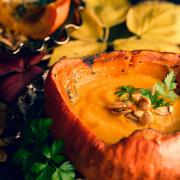February the 14th … is there a more daunting date on the calendar?
There are so many decisions to be made which potentially have lasting consequences: do you plump for a humorous, romantic or rude card?
Should you buy flowers or chocolates, or both?
And then, of course, there’s the meal: if you’re reading this and still haven’t booked a table at your favourite restaurant, I think you’re going to be very late to the tête-à-tête party.
If you find yourself cooking a romantic meal at home out of necessity (and, possibly, fear) you must ensure that you maintain the pretence that this was always the preferred option.
As a veteran of many decades of cooking (for other couples, obviously, I fear my own loved ones have – more often than not – been at home alone) on this most hazardous date, I think I can confidently say that I have seen, and heard, it all.
Down-one-knee proposals, some of which have been declined, couples who come out once a year and sit for hours in complete silence.
Full-blown arguments where we’ve had to call the police, and, my very favourite, when my legendary head waiter told a young lad to go home and get changed, to match the efforts his girlfriend had made.
To be fair, he did that – and promptly – returning in style, looking like a very dapper and very different gentleman.
I think it’s safe to say that staying at home and cooking for your partner is possibly a safer scenario.
I’m afraid a takeaway just won’t cut it if you’re trying to showcase your adoration, so here’s a menu for you that may take a little thought, but is a beautiful dinner for two, which will almost guarantee you reap the romantic rewards for your endeavours.
Or at the very least, will mean you don’t have to do the washing up.
Richard Hughes is chef director at The Assembly House Norwich and The Richard Hughes Cookery School, assemblyhousenorwich.co.uk.

Parmesan Custard recipe
This dish became something of a signature dish back in my Lavender House days, and customers still talk of it to this day. As with everything in my repertoire, it was stolen from somebody else. I can vividly remember eating it at the great Rowley Leigh’s Le Café Anglais, where it was served with Sicilian anchovy toasts. The restaurant, a beautiful art deco brasserie in London’s Porchester Gardens, is sadly long gone, however the memory of this little custard is firmly placed on my taste buds.
Ingredients
(Serves 4)
150 ml single cream
150g ml milk
60g finely grated Parmesan
2 large egg yolks
Salt, pinch of cayenne
Method
Mix the cream, milk and all but two teaspoons of the cheese in a bowl and warm gently over a pan of boiling water until the cheese has melted.
Allow to the mixture to stand for 10 minutes before whisking in the egg yolks, salt, and a little cayenne.
Lightly butter 4 x 80ml ramekin moulds and pour in the mixture. Sprinkling the remaining cheese on the top.
Put the moulds in a deep tray, pour in boiling water to create a bain Marie, and cover the try with buttered paper.
Bake in the oven at 150C, fan 130C, Gas Mark 2 for 20 minutes or until the mixture has just set. Leave to cool in the tray. You can serve these delightful savoury pots with bread soldiers, cheese straws or, my favourite, Marmite toast soldiers.

Norfolk Pork, Three Ways recipe; slow-cooked belly, stuffed tenderloin and pork fritter
This is somewhat of a departure from the norm of my usual recipes. It will take a little effort and is best done over two days, but if you can’t make an effort on Valentine’s Day, when can you? It’s really very simple, so don’t be put off, and is a real restaurant standard dish that you can serve in your own home. A plate of food that is dressed to impress.
Pork Belly ingredients
1kg boneless pork belly, cut into 4 (ask your butcher for it be skinned, but ask for the skin and turn it into crackling if you wish)
3 garlic cloves, crushed
1 large onion, sliced
1 tsp flaky sea salt
1 large Bramley apple, peeled, cored and chopped
500ml cider
Tenderloin ingredients;
1 tenderloin of pork
25g butter
50g ready to eat prunes
Seasoning
Pork fritter ingredients
The trim from the pressed pork belly
½ teaspoon English mustard
Fresh sage leaves
Seasoning
Serving suggestions to accompany
Roasted potatoes, crushed new potatoes, broccoli, roasted root vegetables.
Pork Belly; the method: Put the sliced onion, garlic and apple into the bottom of your slow-cooker and place the pork belly pieces on top. Pour on the cider. Cook on high in the slow-cooker for 4 hours. Alternatively, simply place all the ingredients into a deep roasting tray, cover with foil and cook at 140C for 3 to 4 hours, checking frequently.
Once the belly is cooked, carefully take the pieces of pork belly and lay on to a baking parchment lined tray, top with another piece of parchment and top with another tray and press slightly using a couple of cans, and place in the fridge overnight
Liquidise the onions, apples and cider until completely smooth. You may need to add a little water if it is too thick.
On day two, trim the pork belly into neat slices, approximately 12cm x 3.5cm. Keep the trimmings to make the fritters.
To make the tenderloin, trim the pork tenderloin of any sinew, cut in half, through the centre, and using a small sharp knife, make an incision through the middle of the tenderloin and stuff it with the prunes. You’ll get a couple of prunes into each half.
To make the fritter, finely chop the trim and offcuts of the pork belly (you can do this in a food processor). Add ½ teaspoon freshly chopped sage, ½ teaspoon English mustard and season to taste. Roll into balls, pass through flour, egg and white bread crumbs.
To cook and assemble
Pre-heat the oven to 180C, Fan 160C, Gas Mark 4.
Spread the tenderloin in butter and season. Roast for 12 minutes, turning over with a set of tongs after 6 minutes. Remove from the oven, cover in foil and rest for 10 minutes.
Pan-fry the pork belly in oil and butter until golden brown. Place into the oven for 10 minutes.
Either deep-fry your fritter until golden brown and hot in the centre, or brush with melted butter and bake in the same oven for 15 minutes.
Heat your sauce made from the cooking liquor. Adjust the consistency with water, and check the seasoning.
Cut the pork tenderloin into four pieces, to show the prune. Arrange all the ingredients on the plate, and dress with the sauce. I’ve served mine with crushed new potatoes, sprouting broccoli and a few warmed prunes. If you’ve made the crackling, add that. I’ve also deep fried a few fried crispy sage leaves, because I’m a chef and that’s what we do.
If you want to add more vegetables such as roasted carrots and parsnips, serve these in a separate dish. You don’t want to spoil your masterpiece!

Black Forest Meringues recipe
A simple impressive dessert. The meringues and cherries can made a day in advance and the syllabub and assembly of the dish can be done very quickly at the last moment.
For the meringues
3 large, organic egg whites
175g white caster sugar
½ tsp vanilla extract
75g dark chocolate, melted
For the syllabub
250ml of double cream, or whipping cream
1 tbsp of kirsch, optional
250g caster sugar
25ml water
250g of cherries (if you can find them, but the French griottine cherries marinated in Kirsch – they are absolutely delicious, but very addictive!)
1 chocolate flake, broken
Method
Preheat the oven to 140°C/Fan 120°C/Gas Mark 1.
In a large, grease-free mixing bowl, whisk the egg whites to soft peaks. While continuously whisking, slowly add the caster sugar – 1 tbsp at a time – until you have a stiff, glossy meringue mixture.
Whisk in the vanilla extract until combined.
Line a baking tray with baking paper, fixing it in place with a tiny blob of meringue in each corner
Using a metal spoon, place 6 heaped spoons of meringue onto the baking paper, well-spaced apart. Using the back of the spoon, make an indentation into the top of the meringue, where the syllabub will sit
Bake for 1¼ hours for mallowy centres, or 1½ hours if you prefer crisper meringues.
Peel off the baking paper, then transfer the mallowy meringues to a wire rack to cool, or leave the crisp ones in the turned-off oven for at least 4 hours to cool slowly, then transfer to a wire rack.
When the meringues are completely cool, dip the bottoms into the melted chocolate. Carefully place onto baking paper until the chocolate has set.
To make the syllabub; warm the cherries with the Kirsch, the caster sugar and 25ml water. Simmer gently until the sugar and water makes a syrup. Cool. Whip the cream until it reaches the ribbon stage, add a dessertspoon of the cherry liquor, the kirsch if using, and continue to whip until thickened.
To assemble, pile the syllabub and cherries onto the meringues. Spoon over some of the syrup, and top with flaked chocolate.


























